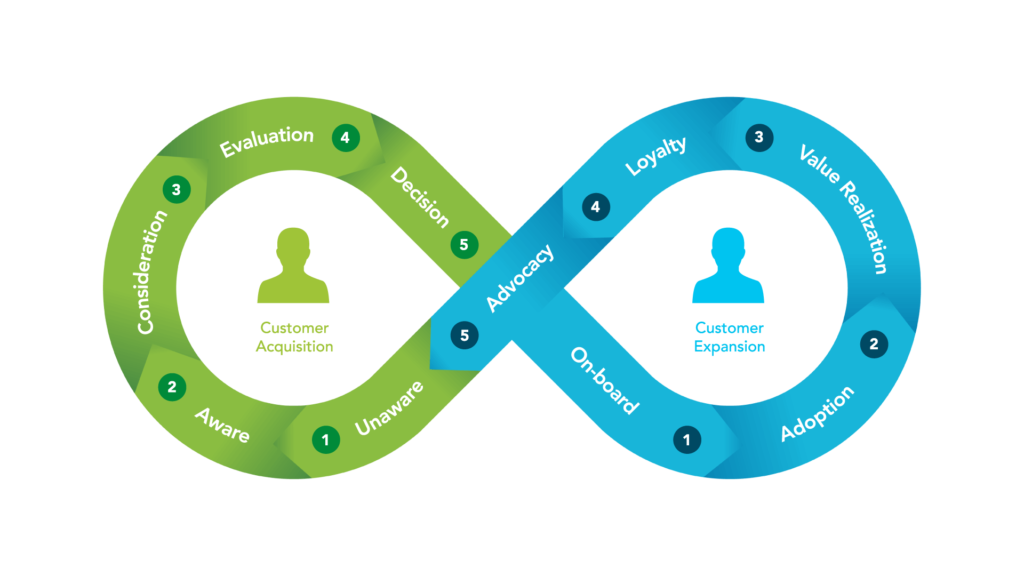As the digital sphere continues to get more and more cluttered, it’s harder and harder to remain top-of-mind to key buyers.
Marketers may be considering an omni-channel marketing strategy as a response, with the purpose of staying in front of customers and prospects alike throughout a typical buying cycle.
B2B buyers are searching for B2B solutions just as they would for consumable products – through various channels, many (but not all) of which are digital. It must be a top-down initiative across your entire organization, so you need buy-in from leadership.
Many organizations proclaim they want to go omni-channel. So, let’s start with a key distinction:
What is the difference between omni and multi-channel marketing?
- Omni-channel is a high-level strategy to ensure an organization’s brand is accessible across any and all channels, providing a seamless experience for all customers and prospects no matter the channel.
- Multi-channel is a tactic that defines the channels used within a campaign. Not all campaigns can or should be “omni-channel,” but all campaigns should use both inbound and outbound components to optimize campaign success. Demand generation marketing should include at least 2-4 channels per campaign.
With these definitions, we see omni-channel is a top-down strategy that must be adopted across the organization. It is usually embedded into the executive vision and implemented across multiple departments. It takes an organizational shift from siloed operations to a single view of the customer.
Multi-channel marketing is a subset – it’s a marketer’s best tactic to implement omni-channel marketing through campaigns. Marketers should be very strategic in selecting their channels, as a shift from a single channel to multiple adds complexity to a campaign.
There are a few factors that shape how you choose which channels to utilize for your multi-channel campaigns, these factors can be grouped into internal factors from your organization and external factors for the target audience preference:
Internal Factors
According to a Forrester report, 44% of organizations highlight difficulty in integrating back-office technology as a major barrier to the omni-channel experience (source). Marketers need to be aware of the gaps in your technology stack in order to properly choose the right channels. As demand generation marketing demands more and more marketing technologies, integrations become crucial to omni-channel marketing success.
Budget and resource and data availability also play a factor in channel selection from an internal perspective.
External Factors
First and foremost: Your customers’ preference. Organizations should leverage real customer data to understand where their customers are interacting and engaging with their buyers. Channel factors include the customer persona preference, what stage they are in the buying cycle, preferred digital watering holes (perhaps by industry) as well as previously-documented behavior.
Inbound lead sources are a great indicator of which channels to explore first in your lead generation efforts.
Omni-channel strategic initiatives can be realized with multi-channel marketing campaigns. As demand generation marketers, it is our job to select the right channels for our target audience as well as the organizations. If there is a major gap between the two, the campaign will not be successful. Analyze your current channel need and your current channel mix to indicate whether or not your organization is ready for omni-channel marketing!
Omni-Channel Statistics You Should Know:
It takes more than a single interaction to engage a customer:
- In B2B, buyers spend less than 20% of their buying journey speaking with potential suppliers (Gartner)
- The three most common lead generation strategies are email marketing, event marketing, and content marketing (DM News)
- Users often take dozens, if not hundreds, of digital touchpoints on their journey (Think With Google)
- Only 48% of respondents craft content based on specific stages of their buyer’s journey (Content Marketing Institute)
- 70% of marketers lack a consistent or integrated content strategy (Altimeter, via Venture Harbor)
- Respondents with 7+ marketing channels in their mix are 26% more likely to say it’s producing good or very good results (PFL)
Many organizations want to conduct omni-channel campaigns, but have trouble executing. Did you know that per Invesp, more marketers have adopted multi-channel marketing strategies to stay on top of market tends than because of the ROI of their campaigns?
Related: Be a champion in your organization with revenue marketing principles
Those who are successfully implementing omni-channel see results and have a competitive advantage:
- 46% of organizations currently deliver poor customer experiences that end up in cart abandonment. (Multichannel Digital Marketing Report)
- Only 14% of organizations say they are currently running coordinated marketing campaigns across all channels. (CMO by Adobe)
- 51% of marketers can’t react to new channels, devices, trends or competitors using their current tech. (Multichannel Digital Marketing Report)
- 55% of companies have no cross-channel strategy in place (The CMO Club)
- 64% of marketers cite lack of resources and investment as their top barrier to omni-channel marketing (The CMO Club).
- More than half of organizations say that “non-integrated tech platforms” are the single biggest barrier to running more integrated marketing activities. (CMO by Adobe, Three Issues Hindering Progress In Multichannel Marketing)
- Companies with robust omnichannel customer engagement see a 9.5% year-over-year increase in annual revenue, compared to 3.4% for companies that don’t have one. (Aberdeen Group)
Related: Grab any of these 100+ Customer Experience Statistics and bulk up your business case

Buyers (both B2B and B2C) expect a seamless online buying experience, regardless of the channel:
- Omni-channel shoppers have a 30% higher lifetime value than those who shop using only one channel (IDC ,via Think With Google).
- 98% of Americans switch between devices in the same day. (Google Research)
- Only 45% of #B2B marketers achieve the goal to build subscribed audiences. (Content Marketing Institute)
- 45% of brick-and-mortar buyers check online reviews before buying (BazaarVoice)
- 78% of B2B customers (and 83% of consumers) say fulfillment options – such as next-day delivery – are important or very important. (The Future of Commerce)
- 71% of shoppers who use smartphones for research in-store say that it’s become an important part of the experience. (Google).
- 61% of customers have not been able to easily switch from one channel to another when interacting with customer service (Aspect).
- 52% of consumers polled like it when customer service is personalized to them and their interests. (Opinium Research LLP, Ovum)
If you want to build a personal, frictionless experience for your customers, look at our Marketing Operations consulting.
Marketing leadership is obsessed with customer engagement.
Showcase to your marketing leaders that this is a hot topic among their peers:
- 86% of senior-level marketers agree that it’s important to create a cohesive customer journey across all touchpoints and channels.” (The State of Marketing Leadership – Salesforce + LinkedIn)
- 81% percent of CxOs anticipate more digital interaction with customers by 2020, and 66% expect more focus on customers as individuals. (Silverpop)
Omni-channel marketing impacts customer engagement:
- Companies with extremely strong omni-channel customer engagement see a 9.5% year-over-year increase in annual revenue, compared to 3.4% for weak omni-channel companies. Similarly, strong omni-channel companies see a 7.5% year-over-year decrease in cost per contact, compared to a 0.2% year-over-year decrease for weak companies. (Aberdeen Group)
- Businesses that successfully employ a consistent cross-channel marketing strategy enjoy a 14.6% year-over-year increase in annual revenue (Omer Minkara: Customer Engagement: From Interactions to Relationships)
- 50% of multi-channel marketers say they “usually” or “always” hit their financial targets. (CMO by Adobe, Three Issues Hindering Progress In Multichannel Marketing)
I hope these omni-channel stats are useful to helping build the business case at your organization!
So, what now?
- Master crucial building blocks in your marketing: mapping your buyer’s journey and lead management
- Dive into new ways of thinking, from inbound to ABM to marketing operations, on our Trending Topics hub!
